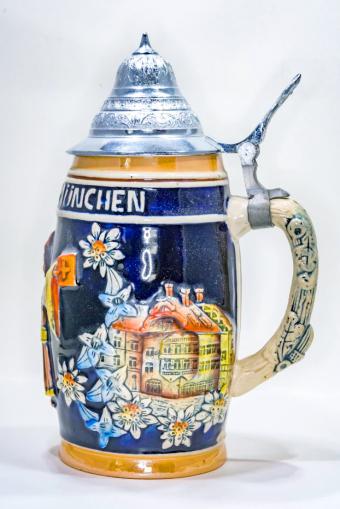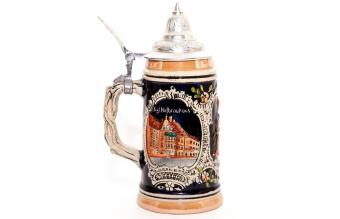Where To Find A Beer Stein Repair Person Near Me
Antiquarian High german Beer Steins: Values and History
Updated January 31, 2022

The primeval antique German beer steins date to the 14th century, a fourth dimension when earthenware was being improved, Germany was making new and improved brews, and Europe was ravaged with the bubonic plague. Replica and aged beer steins are still manufactured today, so you lot need to empathise the history of these vessels to larn German beer stein values.
History of German Beer Steins
Beer steins evolved as a upshot of the laws passed in several German principalities stating that covers had to be on all beverage and food containers. The laws, and others related to germ-free atmospheric condition, were in reaction to the fright that a recurrence of the bubonic plague, also called the Black Death, would exist caused by several invasions of flies throughout Central Europe in the mid to late fifteenth century. Up until that time, nearly common folk drank beer from mugs fabricated of porous earthenware or wood. The well-to-do and upper form drank from glass, pewter or silvery vessels, called beakers or tankards.
Mugs With Hinged Lids
The outset steins were simply mugs with a hinged lid that had an attached thumb lift. As progress continued in the refinement of earthenware, a new cloth developed called stoneware. Chip and cleft resistant, the new non-porous cloth was a perfect choice for holding beer.
Relatively expensive, the stoneware lidded drinking vessels before long became the subjects of Renaissance artists that added designs to make them even more appealing. Early German beer steins from the 14th to the 17th centuries frequently had:
- Carved or applied decorations and decorative detailing
- Carved or applied scenes including figurative, historical and Biblical
- Carved or practical shields
- A clear salt glaze
- A chocolate salt glaze
- A cobalt oxide blue glaze
- A manganese oxide majestic glaze

The Introduction of Faience
By the mid-17th century, German beer and stoneware beer steins were in high need. The aristocracy members of the German language society wanted elaborately decorated steins made of silver, pewter, or drinking glass which were fabricated in Bavaria, Koblenz and Koln. However, there was also cracking attention paid to the cute porcelain Ming mugs of China. Although at the time European potters did not know how to produce porcelain, German potters produced a substitute for porcelain, called faience.
Beer steins made of faience, a type of earthenware that uses tin oxide to create a white porcelain looking glaze, speedily became popular in Germany. The German faience steins were:
- Less expensive than the Chinese porcelain pieces
- Adorned with beautiful decorative designs and motifs in late Renaissance and early on Baroque styles rather than Chinese designs
- Beautifully glazed since the High german blue glaze was purer than the Chinese blueish coat, giving the steins stunning coloring and crisp lines
Porcelain Antiquarian High german Beer Steins
Many German beer stein makers connected making faience steins throughout the 18th century. At the aforementioned time, European porcelain had been perfected and the costly German porcelain beer steins were in need by Germany'southward wealthiest families.
Besides porcelain, several other materials were used in the making of beer steins during this time menstruum. Like the porcelain steins, beer steins fabricated of the following materials were also very costly:
- Enameled glass
- Engraved glass
- Silver
- Ivory

Steins of the Mid-19th to Early 20th Century
The German beer steins produced from the mid-19th to early on 20th century saw a resurgence in the popularity of stoneware steins busy with Renaissance designs and motifs. These steins were:
- Made using clay from the Koln area, which has a distinctive white color
- Decorated in the Renaissance style, often having relief decorations
- Colored using a gray salt glaze
- Topped with lids of inlaid porcelain
This era is besides the beginning of molded German beer steins. The first molded steins were made in the region of Westerwald past Reinhold Hanke. Once molds were used and beer steins were existence mass produced, the beautiful highly detailed carved relief work of the early steins was no longer unique. It appears on hundreds, if non thousands, of molded steins.

German Stein Values
Antique High german beer stein values range from $50 to $five,000. Knowing everything you can about your stein and the current market for them with collectors can hateful the departure of thousands of dollars.
- Auctioneer Ron Fox shared that he once sold a 17th century American tankard, a type of stein, for $140,000 dollars. It had been passed down through generations of a unmarried family, so information technology had first-class provenance.
- In 2018, a 1900 German regimental stein sold for a little over $6,000. This stein had a rare style of trunk and hat, making information technology particularly valuable to bidders.
- A circa 1900 Marzi & Remy pewter chapeau stein sold in 2022 for about $145. This is a archetype stein manufacturer, and despite the fact that there was no maker'due south mark on the stein, it fit the style of this company.
- A cute sterling argent stein dating to 1763 fetched more that $2,200 at auction in 2022. It was in excellent condition for its age and was fabricated of precious materials.
- A figural stein in the shape of Dracula sold for nearly $500 on eBay in 2022. It was designed by renowned artist Greg Hildebrant and was in excellent condition.
- A vintage Budweiser Clydesdale stein dating to 1981 sold for about $90 in 2022. Although this wasn't antique, it was part of a express series that is highly collectible.
How to Tell if Your German Beer Stein Is Valuable
German beer steins can sell for nether $50 or over $5,000, merely many sell in the $100 to $500 range. To decide whether your stein is a valuable antique or just a absurd collectible, yous need to look for clues about how one-time the stein is, where information technology was made, and how it was made. The best way to detect the value of your stein is to seek a professional appraisal from a stein skilful.
Tips for Authenticating Your German Beer Stein
To start, you lot'll desire to be fairly certain your beer stein is an authentic German antique, not a mass-produced promotional piece.
- If the inside of the pewter hat is lighter than the outside, that indicates actuality.
- Hand-painted steins volition have pocket-size imperfections and feel raised. These are more valuable.
- Paw-carved designs indicate actuality, and those with a German patriotic scheme can exist more than valuable.
- Scenes on the stein should tell a story. A design of Biblical nature or a historical event can be more valuable.
- The design on the lid should stand for with the design on the stein to show that the entire piece is intact.
Tips for Dating Your German Beer Stein
Finding the menstruum when your stein was made is important because older pieces will typically be more valuable.
- Look for markings that signal it was made in Germany. This was a requirement of exports later on 1887. Phrases like "Gemacht in Germany" or "Fabricated in Germany" are common.
- Beer stein handles didn't go bumps on them until the 1920s, so the lack of a bump can help date your piece.
- A number on the stein that starts with "17," "18" or "19 is non necessarily a manufacture date. If the number is behind the handle or imprinted in the base, it'due south probably just a form or mold number.
- Pewter lids made before WWII used a three or four function mold, while more recent pewter lids are fabricated in a single mold.
- A stein marked equally fabricated in Western Federal republic of germany indicates it was fabricated between 1949 and 1990.

Stein Status Impacts Value
Beer steins were fabricated to be used, so finding faded colors, small-scale chips, and other small-scale imperfections is expected with antiques. But the condition of your stein will affect its value. If your piece has many or all of these conditions, information technology will be more valuable.
- All original pieces are intact
- Very few chips, dents or cracks
- No obvious repair work
- Original decorations are articulate
- No unattractive discolorations
- Fiddling to no damage to the forepart
- Working hinge on chapeau
Popular German Beer Stein Manufacturers
Stein makers often mark their work with easily identifiable maker'southward marks. You lot can search online databases such equally Stein Marks to identify yours. Well-known manufacturer pieces can be more than valuable. The post-obit are some makers of German beer steins.
- Albert Jacob Thewal
- Diesinger
- Dumler and Breiden
- Eckhardt and Engler
- Handgemalt
- Hauber and Reuther
- J. Westward. Remy
- Marzi and Remy
- Merkelbach and Wick
- Mettlach
- Rastal Werk
- Reinhold Hanke
- Reinhold Merkelbach
- Smion Peter Gertz
- Villeroy and Boch
Collecting German Beer Steins
Although you will not find antique German beer steins fabricated of early stoneware or faience in local antique stores or online auctions, in that location are many beautiful beer steins made in centuries by available to collectors.
© 2022 LoveToKnow Media. All rights reserved.
Source: https://antiques.lovetoknow.com/antique-german-beer-steins
Posted by: brisenohumbeas.blogspot.com



0 Response to "Where To Find A Beer Stein Repair Person Near Me"
Post a Comment